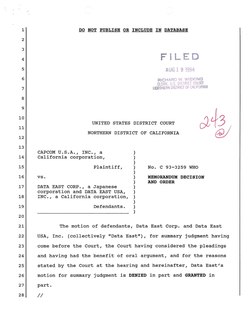Software:Capcom U.S.A. Inc. v. Data East Corp.
Capcom U.S.A. Inc. v. Data East Corp., 1994 WL 1751482 (N.D. Cal, 1994) was a 1994 legal case related to the copyright of video games, where Capcom alleged that Data East's game Fighter's History infringed the copyright of Capcom's game Street Fighter II. It was revealed that the design documents for Fighter's History contained several references to Street Fighter II, leading Capcom to sue Data East for damages, as well as a preliminary injunction to stop the distribution of the infringing game. In spite of the intentional similarities between the two games, the court concluded that Data East did not infringe upon Capcom's copyright, as most of these similarities were not protected under copyright. Judge William H. Orrick Jr. applied a legal principle known as the merger doctrine, where courts will not grant copyright protection where it would effectively give someone a monopoly over an idea.
Although early cases such as Atari v. Philips ruled against a game for infringing on the copyright of Pac-Man, they also noted that any standard elements of a game could not be protected by copyright. Courts would later expand on this principle, establishing that copyright did not protect generic concepts, functional rules, and scènes à faire. This included an earlier legal dispute, where Data East lost their case against an alleged video game clone of their game Karate Champ because none of the similarities were protected under copyright. Now years later, Data East found themselves on the other side of a similar dispute, and the court determined that the contents of Fighter's History were legally permissible. This trend of a more permissive approach to copyright continued until 2012, when rulings such as Tetris Holding, LLC v. Xio Interactive, Inc. and Spry Fox, LLC v. Lolapps, Inc. ruled that more specific forms of copying are unlawful.
Background
Facts
In 1991, Game developer Capcom released Street Fighter II. Its popularity led to an explosion of interest in the fighting game genre.[1][2] Other companies rushed to capitalize, and Data East released their own one-on-one fighting game called Fighter's History in 1993.[3] Even compared to other fighting games, there were many similarities between Fighter's History and Street Fighter II, with both games having similar character designs and artwork, as well as similar special moves and controls.[1] As it was later revealed, Data East created design documents that referred to Street Fighter II several times.[1] Several people noticed the similarities and raised the issue with Capcom, reaching the president, Kenzo Tsujimoto.[4] Capcom soon sued Data East for copyright infringements, in both America and Japan.[5] Capcom sought 623 million yen in damages,[6] as well as a preliminary injunction to stop Data East from distributing Fighter's History.[7]
— Claude Stern, trial counsel representing Data East[4]
Law
This dispute would depend on whether the copied elements of Street Fighter II were actually protected by copyright.[8] Data East called on expert witness Bill Kunkel, a game journalist who testified in Atari v. Philips that not all copying is infringing, such as the similarity between K.C. Munchkin! and Pac-Man.[1] The court ruled that K.C. Munchkin! did infringe the copyright of Pac-Man, because the games had substantial similarities.[9] However, the court also noted that several aspects of the games were standard or common, and thus not protected by copyright.[10]
By the late 1980s, courts began to take a more permissive approach with video game clones, deciding that many elements of creativity cannot be protected, such as generic concepts, functional rules, and scènes à faire.[8] One such ruling was the 1988 case Data East USA, Inc. v. Epyx, Inc., where courts ruled that Epyx's game World Karate Championship did not infringe Data East's game Karate Champ, because none of the similarities were protected under copyright.[8] Now years later, Data East argued that their game Karate Champ was the first game in the fighting genre.[6] Data East also argued that the similarities between their game and Street Fighter II were not protected by copyright, as they were both inspired by the same form of game, and the same stereotyped characters in the public domain. Data East was confident in their argument, because Epyx had used the same argument against them in Data East v. Epyx, where courts found that copyright did not protect the general ideas in Karate Champ.[11]
Ruling
The trial took place on October 31, 1994. Judge William H. Orrick Jr. stated that there was strong evidence that Data East set out to imitate the success of Street Fighter II, noting similarities such as a "Chun-Li clone" (referring to Feilin) and several comparable special moves.[5] The court noted that "of the eight pairs of characters and twenty-seven special moves at issue, three characters and five special moves in Fighter’s History are similar to protectable characters and special moves in Street Fighter II".[12] Although the court determined that several moves were similar, the court also noted that "Street Fighter II has a total universe of twelve characters and six hundred and fifty moves. Capcom concedes, as it must, that the vast majority of the moves are unprotectable because they are commonplace kicks and punches."[12]
In the end, Capcom lost the case on grounds that the copied elements were excluded from copyright protection, as generic scènes à faire.[13] Judge Orrick applied a legal principle known as the merger doctrine, where courts will not extend copyright protection if it effectively gives someone a monopoly over an idea. The court affirmed that "copyright protection does not encompass games as such, since they consist of abstract rules and play ideas. It follows, therefore, that audiovisual works like the two presently before the Court are largely unprotectable games."[12]
Legacy
As a historic ruling, Capcom v. Data East expanded on the principle that generic similarities between games are allowable under copyright law.[10] Data East established that Fighter's History was not infringing based on the precedent from Data East v. Epyx, which Nadia Oxford of 1UP.com noted as "ironic" because Data East lost the older case.[14] Courts continued this approach for many years, ruling in favor of most video game clones until enforcing some limits in the 2012 case Tetris Holding, LLC v. Xio Interactive.[10] Tetris v. Xio found that copyright does protect a game's more specific elements from infringing copies, compared to the ruling in Capcom v. Data East that suggests a more skeptical view towards copyright protection for video games.[12]
John Quagliariello argues that this was one of several cases that made it near impossible for a video game copyright holder to win a lawsuit against a potential infringer, especially considering the cost of a lawsuit versus the risk of an unfavorable ruling.[15] Chris Kohler of Kotaku argues that this ruling prevented a chilling effect on game creation, allowing video game genres to develop through imitation and iteration.[1] Attorney Stephen C. McArthur mentioned it among several rulings that were permissive of clones, such as Atari v. Amusement World and Data East v. Epyx, a pattern that changed in 2012 with Tetris v. Xio and Spry Fox, LLC v. Lolapps, Inc.[8]
References
- ↑ 1.0 1.1 1.2 1.3 1.4 "The Fighting Game Capcom Tried To Get Pulled From Arcades" (in en-us). 3 January 2019. https://kotaku.com/the-fighting-game-capcom-tried-to-get-pulled-from-arcad-1831460432.
- ↑ DeMaria, Rusel (2018-12-07) (in en). High Score! Expanded: The Illustrated History of Electronic Games 3rd Edition. CRC Press. ISBN 978-0-429-77139-2. https://books.google.com/books?id=dAF-DwAAQBAJ.
- ↑ "話題のマシン (Game machine in the news)" (in ja), ゲームマシン (Game Machine) (アミューズメント通信社 (Amusement Press Inc.)) 446: 20, 1 April 1993
- ↑ 4.0 4.1 "Street Fighter 2: An Oral History (Chapter 4)". https://www.polygon.com/a/street-fighter-2-oral-history/chapter-4.
- ↑ 5.0 5.1 "Capcom, Data East in Fighter's Fight". GamePro (IDG) (59): 182. June 1994.
- ↑ 6.0 6.1 "Capcom sues Data East over Street Fighter II". Play Meter 20 (1): 16. January 1994. https://archive.org/details/play-meter-volume-20-number-1-january-1994/Play%20Meter%20-%20Volume%2020%2C%20Number%201%20-%20January%201994%20%28Compressed%29/page/16/mode/1up.
- ↑ Capcom U.S.A. Inc. v. Data East Corp., 1994 WL 1751482 (N.D. Cal. 1994)
- ↑ 8.0 8.1 8.2 8.3 "Clone Wars: The Five Most Important Cases Every Game Developer Should Know" (in en). 27 February 2013. https://www.gamasutra.com/view/feature/187385/clone_wars_the_five_most_.php.
- ↑ Lampros, Nicholas M. (2013). "Leveling Pains: Clone Gaming And The Changing Dynamics Of An Industry". Berkeley Technology Law Journal 28: 743–774. https://www.btlj.org/data/articles2015/vol28/28_AR/28-berkeley-tech-l-j-0743-0776.pdf. Retrieved January 19, 2021.
- ↑ 10.0 10.1 10.2 Eyman, Douglas; Davis, Andréa D. (2016-04-06). Play/Write: Digital Rhetoric, Writing Games. Parlor Press LLC. ISBN 978-1-60235-734-1. https://books.google.com/books?id=hasWEAAAQBAJ.
- ↑ Wolf, Mark J. P. (2021-05-24) (in en). Encyclopedia of Video Games: The Culture, Technology, and Art of Gaming, 2nd Edition [3 volumes]. ABC-CLIO. ISBN 978-1-4408-7020-0. https://books.google.com/books?id=fc0vEAAAQBAJ.
- ↑ 12.0 12.1 12.2 12.3 Dean, Drew S. (2016). "Hitting reset: Devising a new video game copyright regime.". University of Pennsylvania Law Review 164 (5): 1239–1280. https://scholarship.law.upenn.edu/cgi/viewcontent.cgi?article=9526&context=penn_law_review. Retrieved January 19, 2021.
- ↑ Capcom U.S.A. Inc. v. Data East Corp. 1994 WL 1751482 (N.D. Cal. 1994). Analysis at Patent Arcade accessed June 18, 2009.
- ↑ Oxford, Nadia (2005-12-14). "History of Videogame Lawsuits from 1UP.com". http://www.1up.com/do/feature?pager.offset=2&cId=3146206.
- ↑ Quagliariello, John (2019). "Applying Copyright Law to Videogames: Litigation Strategies for Lawyers". Harvard Journal of Sports and Entertainment Law 10: 263. https://harvardjsel.com/wp-content/uploads/sites/9/2019/05/HLS204.pdf.
 |



